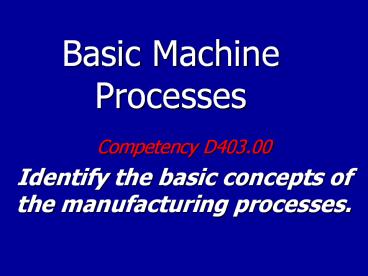Basic Machine Processes - PowerPoint PPT Presentation
1 / 26
Title: Basic Machine Processes
1
Basic Machine Processes
- Competency D403.00
- Identify the basic concepts of the manufacturing
processes.
2
Basic Machine Processes
- Objective D403.01
- Explain the concepts of the manufacturing process.
3
Manufacturing
- Arrived from the Latin word manu factus,
meaning made by hand. - Manufacturing is the process of converting raw
materials into products.
4
WHY STUDYMANUFACTURING PROCESSES?
- The designer and the drafter must have a working
knowledge of the various processes that could
produce a part in order to lower cost and reduce
production time.
5
Three Phases Of The Manufacturing Process
- Product design.
- Selection of materials.
- Selection of production methods and techniques.
6
The information needed to produce a part, most
often comes in the form of a
- Working Drawing
7
Three Main Stages Of The Production Of A Machined
Part
- Rough Forming
- Casting, Forging, Welding
- Finishing
- Drilling, machining, surfacing
- Assembling
- The assembly of parts
8
The Casting Process
- First a pattern is made.
- Then a cavity is made by placing a pattern in wet
sand. - Next molten metal is poured into the cavity of
damp sand.
9
The Casting Process
Machined Finish
Rough Casting
- The rough casting is now ready for the machine
shop. - Holes are then bored and reamed.
- Top and bottom surfaces are machined
- Smaller holes will be drilled and counterbored.
- All corners on cast parts are fillets and rounds.
10
Forging Process
- Forging is produced by using heavy mechanical
presses or hammering heated bars of metal between
dies. - Advantages of forging over sand casting are that
forged parts are much stronger and less brittle.
11
Welding
Welded
Cast
- Welding is the fusion or joining of two pieces
of metal by means of heat, with or without the
application of pressure.
12
Manufacturing Materials
- Fall into three general categories
- Metal
- Plastic
- Inorganic materials
13
Metals are classified as
- Ferrous - contain iron and steel.
- Nonferrous - do not have iron content (such as
copper and aluminum). - Alloys - mixture of two or more metals.
14
Inorganic Materials Include
- Carbon and graphite - have low tensile strength
(ability to be stretched). - Ceramics are clay and glass materials. (resistant
to heat, chemicals, corrosion).
15
Heat-Treating
- Annealing is the process generally used to
soften metal by heating followed by slow cooling. - Hardening requires heating and then rapid
cooling in oil or water.
16
Plastics Processing
The plastics industry represents one of the
major manufacturing segments.
- Thermosetting becoming permanently hard and
unmoldable when once subjected to heat.
- Thermoplastic becoming or remaining soft and
moldable when subjected to heat.
17
Typical Plastic Processing Operations Include
- Extrusion
- Blow Molding
- Injection Molding
- Thermoforming
18
Extruding
- The process of producing shapes by forcing hot
metal through a die that has and opening of the
desired shape.
19
Blow Molding
- Used in the production of bottles, automotive
ductwork, hollow toy components, and door panels.
20
Injection Molding
.
- Used to manufacture products such as housings
for electronic implements, automotive components,
food storage containers, and components for
medical applications.
21
Thermoforming
- Used in the manufacturing of thin-walled packages
for the food industry. - Manufactured primarily by injection molding.
22
CAD in Manufacturing
- The process of developing a design drawing on a
CAD system and producing it on a computerized
machine is called CAD/CAM. - The process of converting the CAD drawing into a
preprogrammed, coded instructions is called
Computer Numerical Control (CNC). - The advantages of the (CNC) is, better production
and control, increased productivity, decreased
labor and lower production costs.
23
The Machinist Steel Ruler
- Commonly used measuring tool for getting rough
measurements on a part. - The smallest division on the fractional scale is
1/64 (.016).
24
Vernier Caliper
- Precise measuring.
- Decimal, fractional, or metric.
- Often used by drafters to record dimensions from
a machined prototype or part.
25
6 Dial Caliper
Step
Depth
Inside
Inside
4-way Measurement
Outside
26
6 Dial Caliper Three Scales
METRIC (mm)
FRACTIONAL (1/64)
DECIMAL (.XX)

